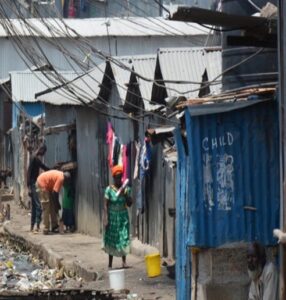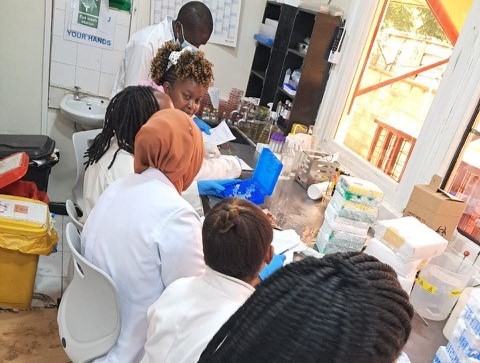Drug-resistant typhoid is a growing global health challenge. Antibiotics have been used to treat typhoid since the 1940s, but current antibiotics may not effectively treat typhoid for much longer given the growing spread of drug-resistant Salmonella Typhi (S. Typhi), the bacteria that causes typhoid. To enhance the understanding of regional and global typhoid transmission patterns, researchers use genomics to analyze genetic similarities and differences in typhoid strains.
A recent study conducted in Mukuru, Kenya – one of Nairobi’s largest urban slums – mapped typhoid samples to better understand their distribution and relatedness. This informal settlement often has a shortage of safe drinking water and inadequate sanitation infrastructure, which increases the risk of typhoid and other waterborne diseases. Further, patients in this region have easy access to over-the-counter medication, which can increase the growth and spread of drug resistance from inappropriate antibiotic choice, unfinished treatment courses, and/or incorrect dosages.
The research team looked at 35 typhoid samples from Mukuru and found connections between S. Typhi isolates from India, Rwanda, Tanzania, and Uganda, which suggests both local and cross-border transmission. Further analysis found ongoing genetic exchanges between isolates in Kenya and Tanzania specifically. Results show close relatedness of drug-resistant typhoid strains across the five countries, an indication of ongoing transmission events.
Diseases cross borders easily so understanding transmission patterns within a country and region helps decision-makers to implement effective control measures to reduce pathogen spread. The results from the study may help national decision makers consider the incidence of typhoid in their country and the potential typhoid risk within their regions.

Study findings support use of typhoid prevention and control methods
Study findings highlight the importance of prevention through immunization and improved water, sanitation, and hygiene (WASH). Typhoid conjugate vaccines (TCVs) are safe, effective, and offer protection for at least four years. TCVs are a crucial tool to combat drug-resistant typhoid. Data from Pakistan found that TCVs are 97% effective against multidrug- and extensively drug-resistant typhoid and a global analysis projects that TCVs will significantly reduce drug resistance-associated deaths in children younger than 15 years.
By protecting individuals from infection, TCVs can reduce the incidence of disease caused by drug-resistant typhoid. When protected from typhoid with TCV, treatment isn’t needed as frequently, which helps to avoid a course of antibiotic treatment. This reduces pathogen exposure to antibiotics and lowers the risk of developing resistance. For this reason, TCVs can limit the spread of drug-resistance through prevention of infection and potential reduction of antibiotic use.
Slowing the spread of drug resistance is an urgent global health priority. The Ministry of Health in Kenya plans to introduce TCVs in 2025, demonstrating great progress in protecting the health of children in the region. These study findings are supportive of the decision to introduction of TCVs to both prevent typhoid illness in children and to minimize the further spread of drug-resistant typhoid both within Kenya and regionally.
Cover photo: Lab staff processing samples from the study. Credit: Kenya Medical Research Institute.



